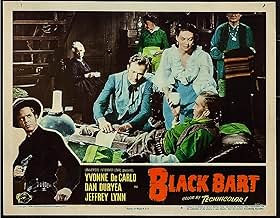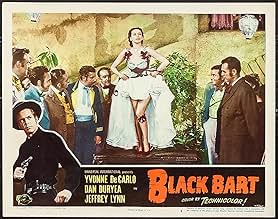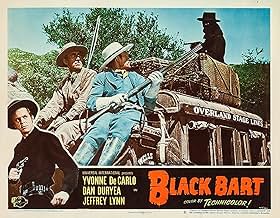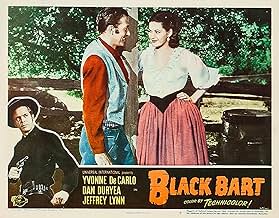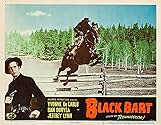CALIFICACIÓN DE IMDb
6.2/10
507
TU CALIFICACIÓN
Agrega una trama en tu idiomaCalifornia stage robber Black Bart meets European dancer Lola Montez.California stage robber Black Bart meets European dancer Lola Montez.California stage robber Black Bart meets European dancer Lola Montez.
- Dirección
- Guionistas
- Elenco
- Premios
- 2 premios ganados en total
Soledad Jiménez
- Teresa
- (as Soledad Jimenez)
Eddy Waller
- Ed Mason
- (as Eddy C. Waller)
Anne O'Neal
- Mrs. Harmon
- (as Anne O'Neil)
Eddie Acuff
- Elkins
- (sin créditos)
Earl Audet
- Townsman
- (sin créditos)
William Bailey
- Townsman
- (sin créditos)
Ray Bennett
- Henry
- (sin créditos)
Nina Campana
- Mamacita
- (sin créditos)
Opiniones destacadas
Black Bart is an interesting movie and well above the norm for the standard studio product of its day.Not only is it splendidly photographed,with a lustrous use of colour that sets it apart from the herd,it has a wonderfully dry and laconic wit that adds a touch of verbal eloquence to proceedings.Indeed I was reminded at times of "Butch Cassidy and the Sundance Kid"in the banter between characters some of which would have sat well in the mouths of characters in a Philip Barry movie or other practitioners of the drawing room comedy.The script is also insouciantly epigrammatical with a pleasing sense of amorality--its leading characters are outlaws and perfectly at home with themselves and their profession.Naturally.this being a 1948 movie they are not allowed to get away with it but the morality is quite unique for the period
We first meet Charles Bowers,later to become the title character,when he and his compadre "Lance"are about to be hung,a fact they greet with stoicism and flippant banter,when they are rescued by ex banker turned outlaw the grizzled veteran Jersey--well played by Percy Kilbride(old Pa Kettle Himself)They split up and Charles ,with the connivance of an old friend,sets himself up as Black Bart a black garbed highwayman making away with Wells Fargo bounty in a series of stagecoach robberies.Lance and Jersey re-appear,recognise him and try to cut in on the deal.Matters get complicated when Bart falls in love with Lola Montez the celebrated singer and dancer who reciprocates the feeling but insists Bart lay aside his illegal trade and turn to more legitimate pursuits
It is a well acted movie with Duryea and Kilbride especially fine and De Carlo enters into the spirit of things with a brash and outgoing performance
Minor but interesting and I enjoyed it .Give a go -you won't regret it
We first meet Charles Bowers,later to become the title character,when he and his compadre "Lance"are about to be hung,a fact they greet with stoicism and flippant banter,when they are rescued by ex banker turned outlaw the grizzled veteran Jersey--well played by Percy Kilbride(old Pa Kettle Himself)They split up and Charles ,with the connivance of an old friend,sets himself up as Black Bart a black garbed highwayman making away with Wells Fargo bounty in a series of stagecoach robberies.Lance and Jersey re-appear,recognise him and try to cut in on the deal.Matters get complicated when Bart falls in love with Lola Montez the celebrated singer and dancer who reciprocates the feeling but insists Bart lay aside his illegal trade and turn to more legitimate pursuits
It is a well acted movie with Duryea and Kilbride especially fine and De Carlo enters into the spirit of things with a brash and outgoing performance
Minor but interesting and I enjoyed it .Give a go -you won't regret it
This film manages to be relatively non-formulaic, and even more non-historical, though the real Black Bart was indeed named Charles E. Boles as portrayed. British-born Boles, however, did not conduct his outlaw career as a Zorroesque black-clad horseman, but hiked to all his holdups and wore a long linen duster, with a flour sack over his head. He was also pushing 50 when he started robbing the stage. So much for a romantic image! If the intention was to make Bart/Boles a dashing figure, I think another actor would have been a better choice than Dan Duryea, who after all pretty much built his career on playing creeps. But it's always interesting to see a departure, and the script is more clever than that of the routine horse opera of the day.
As Lola Montez, Yvonne De Carlo makes no effort at a real characterization of the famous Countess (former mistress to Ludwig I of Bavaria), but acts-- well, like Yvonne De Carlo, delivering her lines in her usual flat New World tones. The witty, volatile and multilingual Lola (nee Eliza Gilbert), though Irish by birth, affected a sort of Spanish accent to go with her assumed Sevillian identity. De Carlo's dancing, I fear, bears little resemblance to Lola's, but it's always a pleasure to watch Yvonne in her early roles; this film came only three years after her dazzling debut in 1945's "Salome, Where She Danced", in which she played a quasi Lola Montez, thereby confusing the record considerably.
In reference to this: the real Lola never danced as Salome nor visited Arizona, and the town there called "Salome, Where She Danced" was named in 1904, and for quite another lady. To play Lola or a quasi-Lola, De Carlo does certainly fit the bill visually as a stunning blue-eyed brunette with a memorable figure. As to Lola ever encountering Black Bart-- well, when he began his career as a highway robber in 1875 Lola had been in her grave for fourteen years. So much for romance!
As Lola Montez, Yvonne De Carlo makes no effort at a real characterization of the famous Countess (former mistress to Ludwig I of Bavaria), but acts-- well, like Yvonne De Carlo, delivering her lines in her usual flat New World tones. The witty, volatile and multilingual Lola (nee Eliza Gilbert), though Irish by birth, affected a sort of Spanish accent to go with her assumed Sevillian identity. De Carlo's dancing, I fear, bears little resemblance to Lola's, but it's always a pleasure to watch Yvonne in her early roles; this film came only three years after her dazzling debut in 1945's "Salome, Where She Danced", in which she played a quasi Lola Montez, thereby confusing the record considerably.
In reference to this: the real Lola never danced as Salome nor visited Arizona, and the town there called "Salome, Where She Danced" was named in 1904, and for quite another lady. To play Lola or a quasi-Lola, De Carlo does certainly fit the bill visually as a stunning blue-eyed brunette with a memorable figure. As to Lola ever encountering Black Bart-- well, when he began his career as a highway robber in 1875 Lola had been in her grave for fourteen years. So much for romance!
Three tricky outlaws part ways, only to meet up later on opposite sides.
Pretty good Western— somewhere between an A-production and a B. It's an unusually distinguished supporting cast from Lovejoy to McIntyre to Kilbride, along with some good scenic outdoor set-ups that keep the eye entertained even when the action slows down. Reviewer lorenellroy is right—the amorality of Lynn and Duryea is unusual for the period, 1948. It's hard at times to know where their loyalties lie, making the script somewhat—and refreshingly-- difficult to predict. Add a luscious De Carlo who looks ravishing in Technicolor, while turning in a surprisingly artful performance.
So, with these positives, why doesn't the movie impact more strongly than I believe it does. Now I'm as big a Duryea fan as anyone. In fact that's why I tuned in. But for some reason he looks less motivated than usual, draining Bart of needed character color. There's not the usual relish of his better performances. Add to that the other lead, Jeffrey Lynn, who's just naturally colorless, and there's not the needed drive at the movie's center. At the same time, director Sherman has to work in the romantic angle without sagging the tempo, which he does pretty well. But the staging of the final ambush scene is clumsily done—how could the ambushers miss their shots at such close range as Bart and Lance race for the cabin.
Anyway, there's real offbeat potential in the various ambiguities that the script doesn't develop adequately until the end. Nonetheless, the compensations are enough to make this a generally entertaining 80-minutes of cowboy intrigue.
Pretty good Western— somewhere between an A-production and a B. It's an unusually distinguished supporting cast from Lovejoy to McIntyre to Kilbride, along with some good scenic outdoor set-ups that keep the eye entertained even when the action slows down. Reviewer lorenellroy is right—the amorality of Lynn and Duryea is unusual for the period, 1948. It's hard at times to know where their loyalties lie, making the script somewhat—and refreshingly-- difficult to predict. Add a luscious De Carlo who looks ravishing in Technicolor, while turning in a surprisingly artful performance.
So, with these positives, why doesn't the movie impact more strongly than I believe it does. Now I'm as big a Duryea fan as anyone. In fact that's why I tuned in. But for some reason he looks less motivated than usual, draining Bart of needed character color. There's not the usual relish of his better performances. Add to that the other lead, Jeffrey Lynn, who's just naturally colorless, and there's not the needed drive at the movie's center. At the same time, director Sherman has to work in the romantic angle without sagging the tempo, which he does pretty well. But the staging of the final ambush scene is clumsily done—how could the ambushers miss their shots at such close range as Bart and Lance race for the cabin.
Anyway, there's real offbeat potential in the various ambiguities that the script doesn't develop adequately until the end. Nonetheless, the compensations are enough to make this a generally entertaining 80-minutes of cowboy intrigue.
This film starts with two outlaws by the names of "Charles E. Boles" (Dan Duryea) and "Lance Hardeen" (Jeffrey Lynn) being led to a hanging tree out of town after committing several crimes. However, before the nooses can be put around their necks another outlaw named "Jersey Brady" (Percy Kilbride) ambushes the hanging party and springs his two friends. Once freed Charles decides to split up from the other two and heads for California with all of the money taken from a previous heist. Not long afterward he dons a mask and upon assuming the nickname of "Black Bart" proceeds to rob stagecoaches belonging to Wells Fargo. As luck would have it one of the stagecoaches he robs has both Lance and Jersey as passengers along with a famous dancer from Europe by the name of "Lola Montez" (Yvonne De Carlo). Needless to say, their lives become intertwined from this moment on. Now, rather than reveal any more of the film and risk spoiling it for those who haven't seen it I will just say that this was a watchable Western movie for the most part. Although I liked the performances of Yvonne De Carlo and Percy Kilbride to a certain extent, to be quite honest I didn't think Dan Duryea possessed the necessary screen presence to handle the starring role. Likewise, I also thought some of the scenarios were a bit too fanciful and unrealistic for my tastes. Again though, it's certainly watchable and worth the time spent if one is inclined to movies of this type. I rate it as average.
Can you be disappointed if you had no expectations in the first place? In this case: yes. This less than a classic western has an above average idea it fails to deliver. The triangle romance between the zorro- like masked villain, the posing- as- a- good- guy villain and the European dancer- and- mistress- to- the- emperor- of- Austria- turned- saloon singer is actually quite original.
The film, however, is not. The standard western imagery and unimaginative cinematography/direction condemns this film into the "forgettable"- category. Still it must be noted that there is no hero in this western: just two outlaws and a corrupt dame. Although they get their due in the "grand" finale, themes like that are not frequent in the westerns of the classic era but associated usually to westerns in the late 60's and 70's.
The film, however, is not. The standard western imagery and unimaginative cinematography/direction condemns this film into the "forgettable"- category. Still it must be noted that there is no hero in this western: just two outlaws and a corrupt dame. Although they get their due in the "grand" finale, themes like that are not frequent in the westerns of the classic era but associated usually to westerns in the late 60's and 70's.
¿Sabías que…?
- TriviaFilm debut of Frank Lovejoy.
- ErroresOne of the newspaper columns (c. 1849) mentions automobiles.
- Citas
Clark: I've got an idea that's bigger than anything you've ever heard. It'll take time... and it'll take brains.
Charles E. Boles: I got plenty of time.
- ConexionesReferenced in Mystery Science Theater 3000: The Phantom Planet (1998)
Selecciones populares
Inicia sesión para calificar y agrega a la lista de videos para obtener recomendaciones personalizadas
Detalles
- Fecha de lanzamiento
- País de origen
- Idioma
- También se conoce como
- Black Bart, Highwayman
- Locaciones de filmación
- Productora
- Ver más créditos de la compañía en IMDbPro
- Tiempo de ejecución
- 1h 20min(80 min)
- Relación de aspecto
- 1.37 : 1
Contribuir a esta página
Sugiere una edición o agrega el contenido que falta


